Brush Traction
Coordinates: 52°46′55″N 1°11′50″W / 52.78194°N 1.19722°W This article is about a British rail-locomotive maker. For the Detroit auto-maker, see Brush Motor Car Company

Brush Traction is a manufacturer and maintainer of railway locomotives, part of Wabtec Corporation, based at Loughborough in Leicestershire, England situated alongside the Midland Main Line.
| Access to Brush Works from Mainline | ||||||||||||||||||||||||||||||||||||||||||||||||||||||||||||||||||||||||||||||||||||||||||||||||||||||||
|---|---|---|---|---|---|---|---|---|---|---|---|---|---|---|---|---|---|---|---|---|---|---|---|---|---|---|---|---|---|---|---|---|---|---|---|---|---|---|---|---|---|---|---|---|---|---|---|---|---|---|---|---|---|---|---|---|---|---|---|---|---|---|---|---|---|---|---|---|---|---|---|---|---|---|---|---|---|---|---|---|---|---|---|---|---|---|---|---|---|---|---|---|---|---|---|---|---|---|---|---|---|---|---|---|
Legend
| ||||||||||||||||||||||||||||||||||||||||||||||||||||||||||||||||||||||||||||||||||||||||||||||||||||||||
History
Hughes's Locomotive & Tramway Engine Works
In 1865, Henry Hughes, who was a timber merchant engineer, began building horse-drawn tramcars and railway rolling stock at the Falcon Works in Loughborough. His first company was known as the Hughes's Locomotive & Tramway Engine Works Ltd. Records are very sparse, but it seems that he began producing steam locomotives about 1867 for the Paris Exhibition. His main business, however, was tram engines, lightweight steam engines (usually with condensers) which drew passenger cars, made possible by the Tramways Act 1870. Among these was "The Pioneer" for the Swansea and Mumbles Railway. These were distinct from those tramcars where the boiler and mechanism was integral with the passenger car. Amongst the first steam locomotives built there was "Belmont", which ran on the Snailbeach District Railways, and three 2 ft 3 in (686 mm) gauge 0-4-0STs for the Corris Railway supplied in 1878. The Corris locomotives are said to have been works numbers 322, 323 and 324, implying that the tram vehicles and steam locomotives were included in a single numerical sequence.
In 1881 Hughes' built two 3 ft (914 mm) gauge 0-4-0STs for the Liverpool Corporation Water Committee for use in the construction of the waterworks at Lake Vyrnwy in Wales.[1] In 1881 the company ran into legal problems and in 1882 it was in receivership. Hughes departed, soon after, for New Zealand, where in collaboration with local engineer E.W Mills, he built small tramway engines.
Falcon Engine & Car Works
Late in 1882 the company reformed as the Falcon Engine & Car Works Ltd. and supplied three more locomotives of the same design for the railways at Vyrnwy. Again there are few records, but the factory remained busy with both railway and tramway locomotives and rolling stock. Among these were tank locomotives for Ireland, Spain and the Azores. Some were subcontracts from other firms, such as Kerr Stuart, at that time in Glasgow.
Brush Electrical Engineering Company
In 1889 the assets were taken over by the Anglo-American Brush Electric Light Corporation, which had been set up as the British arm of Charles Francis Brush's Brush Electric Company in America. It then became known as the Brush Electrical Engineering Company.
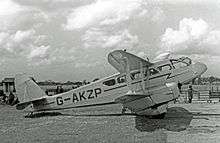
Between 1901 and 1905 the Brushmobile electric car was developed using a Vauxhall Motors engine, although only six were built. One of these six featured in the film Carry on Screaming. Nearly 100 buses, plus some lorries were built using French engines until 1907.
Brush Electrical Engineering also built some carriages that were used in the 1900s on the Central London Railway and the City and South London Railway, the respective forerunners of London Underground's Central and Northern lines.[2]
In all, about 250 steam locomotives were built in addition to the tram engines. Production finished after World War I and the company concentrated on transport-related electrical equipment, including tramcars, trolleybuses and battery-operated vehicles.
In World War II Brush Coachworks diversified into aircraft production, building 335 de Havilland Dominies for the Royal Air Force and Fleet Air Arm. Wing sections were built for Lancaster bombers and Hampden fuselages were overhauled.[3]
The coachworks continued after the war with omnibus bodies mounted on Daimler chassis using Gardner five-cylinder diesel engines and Daimler preselector gearboxes as well as AEC and BMMO Chassis for Midland Red and 100 Leyland Titans for Birmingham City Transport as well as bodies to the design of the British Electric Traction group on Leyland Royal Tigers. In 1952 the coachworks was closed and the goodwill and patents were bought by neighbouring Willowbrook.
Brush Bagnall Traction
Close to Derby and its railway workshops, it retained its contacts with the railway. Acquired by Heenan & Froude in 1947, it was merged with W. G. Bagnall to produce diesel locomotives. In 1951, the company Brush Bagnall Traction Limited was formed.[4] When British Railways began to replace its fleet of steam engines, Brush entered the market for main line diesel-electric locomotives.
Brush Electrical Engineering Company
In 1957 it and Brush Electrical Machines were bought up by Hawker Siddeley to become the Brush Electrical Engineering Company Limited.
Brush Traction
As part of Hawker Siddeley Electric Power Group it then passed to BTR plc and became Brush Traction. It is now part of FKI Energy Technologies (owned, since 2008, by Melrose plc). The locomotive works is still occupied by the Brush Traction Company and is in use for the building, overhaul and repair of locomotives.
On 28 February 2011, Wabtec announced it would purchase Brush Traction for US$31 million.[5]
Locomotives
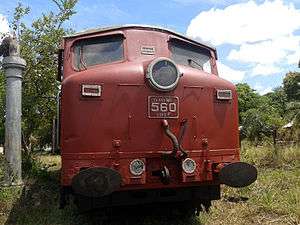
Brush manufactured various diesel and electric locomotives for the British railway network:
- Class 31 "Brush Type 2" mixed-traffic diesel locomotive
- Class 47 "Brush Type 4" mixed-traffic diesel locomotive (manufacture shared with BR)
- Class 53 "Falcon" prototype diesel locomotive
- Class 57 re-engineered diesel locomotive (rebuilt from Class 47)
- Class 60 heavy freight diesel locomotive
- Class 89 prototype electric locomotive
- Class 92 dual-voltage electric locomotive
It also manufactured the Eurotunnel Class 9 electric locomotives operated by Eurotunnel through the Channel Tunnel.
Brush Traction also manufactured locomotives for export:
- 800 bhp A1A-A1A main line diesel-electric locomotives for Ceylon in 1952 (Sri Lanka Railways M1)
- 1000 bhp Bo-Bo diesel-electric locomotives for Sri Lanka in 1981 (the M7 class)
- 1730 bhp Co-Co narrow gauge diesel-electric locomotives for Rhodesia (now Zimbabwe) in 1963
- Various Bo-Bo diesel electric freight locomotives to Cuba, Tanzania, Gabon, Morocco
- Battery electric locomotives to Hong Kong
- EF class heavy freight electric locomotive (New Zealand Railways Corporation)
- Class 18 shunter locomotives for Malayan Railways in 1978
They were also a major supplier of traction equipment to rapid transit systems, in particular London Underground and Docklands Light Railway in the UK, and to Canada and Taiwan. Traction equipment was also supplied to British Rail for various Electric Multiple Unit trains, the Class 43 HST diesel locomotive, similar equipment also being supplied to Comeng in Australia in 1979, and the Class 56 and 58 freight locomotives.
Brush repowered most HST power cars with MTU engines between 2005 and 2010.
Surviving steam locomotives
- No. 3, the third Hughes/Falcon locomotive supplied to the Corris Railway, works number 323 (although incorporating parts from 324 and probably 322 as well) now runs on the neighbouring Talyllyn Railway
- A standard gauge 0-4-0 saddle tank built by Brush Electrical Engineering is preserved at Snibston Discovery Park, Leicestershire
- A broad gauge (seven foot) saddle tank loco built at the Falcon Works survives in the Azores
- 2 ft (610 mm) gauge locomotives Nos. 265 and 266 ex-Beria Railway, at the Phyllis Rampton Trust
- Metre gauge Ex. F.C. Reus - Salou No. 3 0-4-0T Falcon ???/1886.
Preserved in Salou, Spain, on a plinth adjacent to the former terminus of the F.C. Reus-Salou, a former turntable is also outside the old station. Only some 30 metres from the current RENFE station.
- Metre gauge Ex. F.C. Reus - Salou 0-4-0T No.6 Falcon 153/1888
Preserved in a public park in Cambrils near Salou.
- Metre gauge Ex. F.C. Reus – Salou No.5 'SALOU' 0-4-0T Falcon 118/1886.
Preserved at Reus, Spain.
- Metre gauge Ex. F.C. Olot -Gerona No.4 0-6-2T Builder: Falcon 281/1899.
Preserved at Reus.
Surviving diesel locomotives
Over 75 examples of Brush Traction built engines have been preserved, and can be seen at heritage railways across the United Kingdom. Many more examples can still be seen in action today on the mainlines.
Preserved light rail/tramway vehicles
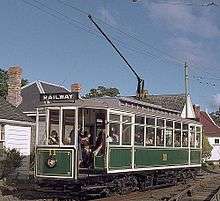
Preserved at Museum of Transport and Technology, Auckland, New Zealand:
- Auckland Electric Tramways Company, No.11 (1902) – double-bogie (Brush D1) saloon tram. Restored
- Auckland Electric Tramways Company, No.17 (1902) – double-bogie (Brush D1) double-decker tram. Unrestored.
- Auckland Electric Tramways Company, No.24 / No.26 (1902) – Privately preserved box cars bodies only, which originally resided on a Brush four wheel trucks. Unrestored.
- Auckland Electric Tramways Company, No.44 – (1906) AETCL built box car body which originally resided on a Brush four wheel truck. Retired 1931. Restored 2006 using a former Brussels 21E truck. Restored.
- Preserved Auckland trams 89 and 91 originally fitted with Brush D1 trucks with Brush 1200 motors and 147 fitted with Brush Improved trucks and 203 refitted with the same.
- Auckland Brush truck remnants. In 2012 excavations at the former Mount Roskill Bus Depot circa 1951 for a new Shopping centre uncovered over a dozen Brush D side frames along with a single Brush improved sideframe and remnants of Brush 1200 and Brush 1400 Motor cases. The side frames are now in MOTAT's possession for research and future Auckland tram restorations with the motor remnants being cared for in private hands for possible replication for various projects. It is believed to be the only Brush 1200 and 1400 motors to have survived in New Zealand if not the world.
- Brush four wheel truck - copy of a 21e Brill. built for the Napier Tramways, New Zealand. Tram number unknown. Tram bodies sold off 1931 after Napier Earthquake. Truck used subsequently as the running gear for a Saw Mill railway shunter. Does not have traction motors.
Preserved in The United Kingdom:
- Chesterfield No.7 (1904)- Preserved at the National Tramway Museum, Derbyshire. Currently operational. Restored from holiday cottage at Tramway Museum 1993-1996.
- Blackpool Tramways No. 298/635 (1937)- Owned by National Tramway Museum, unrestored at their offsite storage facility, awaiting funds, resources and space for a full restoration.
- Blackpool Tramways No.630 (1937) - Preserved at the National Tramway Museum, Derbyshire. Currently operational. Streamlined body. Modernised mid-1990s. Retired by Blackpool Transport in 2011.
- Blackpool Tramways No.623 (1937) - Preserved at the Heaton Park Heritage Tramway, Heaton Park, Manchester. Currently operational. Streamlined body. Retired by Blackpool Transport in 2008.
- Blackpool Tramways No.631 (1937) - Preserved by its original owner as part of their heritage fleet of vehicles. Currently operational. Modernised mid-1990s (though it has now reverted to its 1950s condition) Streamlined body. Retired by Blackpool Transport in 2011.
- Blackpool Tramways No.626 (1937) - Preserved by the Merseyside Tramway Preservation Society. Currently operational but prevented from doing so due to ownership dispute with Merseytravel. Dispute now solved, should enter re-service 2014. Streamlined body. Modernised mid-1990s. Retired by Blackpool Transport in 2010.
- Blackpool Tramways No.634 (1937) - Preserved privately in Rushden, Northamptonshire. Under restoration. Streamlined body. Retired by Blackpool Transport in 2004.
- Blackpool Tramways No.762 (1982)- Preserved at the National Tramway Museum, Derbyshire. Currently operational. Made predominantly from parts of 714 (English Electric 1934), with Brush Trucks and controllers.
Preserved / Operating at: The Manx Electric Railway Isle of Mann
- Manx Electric Railway Rolling Stock with Brush D trucks. Bodies by over builders.
- Nos 1 & 2 (1893)
- Nos 5, 6, 7 & 9 (1894)
- Nos 26 & 27 (1898)
- No 34 (1995) Works Car
Battery-electric vehicles
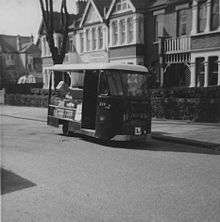
In 1940, Brush required some small battery-electric tractor units, but as none were commercially available, they asked AC Morrison of AE Morrison and Sons (later Morrison-Electricar) to produce a design for one. Morrisons produced a 3-wheeled design, which Brush then used to manufacture a number of units for internal use. Subsequently, they began selling them on the open market, and shipped a large order to Russia in 1941. They added battery electric road vehicles to their product list in 1945,[6] buying the designs and manufacturing rights from Metropolitan Vickers, so that early Brush vehicles are almost indistinguishable from late Metro-Vicks.[7] 3-wheeled vehicles were marketed as the Brush Pony, and they also produced 4-wheeled vehicles.[8] In 1948 they added a 2-ton chassis to their range, which could be supplied with a large van, standard van, flat truck or milk float body. The welded box-section chassis was fitted with semielliptic springs and a Lockhead hydraulic braking system. The 36-cell 290 Ahr battery was mounted on both sides of the central spine. The electric motor was connected to a banjo-type rear axle by a Layrub propellor shaft. In common with other Brush vehicles, control was by a double-depression foot pedal, where the first depression gave two stages of control with the two halves of the battery connected in parallel, and the second depression gave a further two stages with the batteries in series.[9]
In early 1949, they reduced the prices of their electric vehicles by around 25 per cent, in an attempt to make them more competitive with petrol vehicles. The models affected were the 10-14 cwt chassis and the 18-22 cwt chassis, and they were hoping to see a five-fold increase in sales. Sales of their industrial electric truck had trebled between 1947 and 1948. All of their road vehicles were sold through the motor trade, in order to achieve a good standard of after-sales service.[10]
In 1949, they offered 25 standard bodies for their chassis, including a mobile canteen or ice cream parlour, which they exhibited at the Dairy Show that year. The vehicle had a top speed of 16 mph, and a range of 28 miles, based on eight stops per mile.[11] Production of 4-wheeled battery electrics ceased in 1950, although the company continued to manufacture the 3-wheeled Brush Pony milk float, and their range of industrial trucks. They maintained enough spare parts to allow them to service 4-wheeled vehicles for a further 10 years, and sold the remainder to Hindle, Smart and Co of Manchester, who made Helecs milk floats.[12]
In 1972, Hawker Siddeley bought a 50 per cent share in Crompton Leyland Electricars Ltd (CLE), from British Leyland. CLE were the manufacturers of Morrison-Electricar milk floats, and at this point Hawker Siddeley owned Brush, R A Lister and Company, based in Dursley, Gloucestershire and Brook Victor Electric Vehicles, based in Huddersfield, Yorkshire, all of which were producing electric vehicles. In order to rationalise their operations, construction of Brush industrial trucks was transferred to the Morrison-Electricar factory in Tredegar. Although most of the vehicles involved were industrial trucks, the 3-wheeled Brush Pony milk float was also included, and a number of these were subsequently manufactured at Tredegar. Also included was the SD tractor, which was still selling well, and included a drive unit which had originally been designed for Brush by Morrisons in 1940.[13]
An early Brush Pony 3-wheeled milk float, formerly operated by United Dairies and dating from 1947, is on display at the National Motor Museum, Beaulieu.[14] A Brush 10/14 cwt Mark II bread van, also dating from 1947, and formerly owned by the Co-operative Wholesale Society, can be seen at The Transport Museum, Wythall.[15]
Preserved aircraft
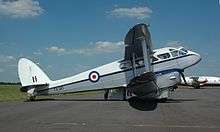
A de Havilland Dominie DH.89 that Brush built in 1946 for the RAF is preserved at Tangmere Military Aviation Museum on the West Sussex coast.
Other relics
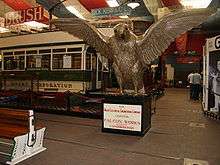
- The large statue of a falcon from these works is now at the National Tramway Museum / Crich Tramway Village, can be found in the exhibition hall there.
See also
References
- ↑ Higgins, S.H.P. (1974). "Narrow Gauge at Vyrnwy Waterworks". The Industrial Railway Record. The Industrial Railway Society. 55: 286–287.
- ↑ Green, Oliver (1988). The London Underground - An Illustrated History. Ian Allan. pp. 19, 22.
- ↑ Jarram, A P. Brush Aircraft Production at Loughborough. Midland Counties Publications, 1978
- ↑ "W G Bagnall Ltd". Buckinghamshite Railway Centre. Retrieved 23 November 2016.
- ↑ "Wabtec buys Brush Traction". Railway Gazette. 28 February 2011. Archived from the original on 28 February 2011. Retrieved 28 February 2011.
- ↑ Roberts 2010, p. 13.
- ↑ Signage on Metrovick FWB 784. The Transport Museum, Wythall.
- ↑ Georgano 1996, p. 25.
- ↑ "2-tonner Added to Brush Range". Commercial Motor. 16 April 1948. p. 33.
- ↑ "Battery Electric Prices Cut by £124". Commercial Motor. 25 February 1949. p. 10.
- ↑ "Battery Electric Canteen". Commercial Motor. 16 September 1949. p. 41.
- ↑ "Spares for Brush 4-wheelers". Commercial Motor. 1 December 1950. p. 34.
- ↑ Roberts 2010, p. 41.
- ↑ "Brush Pony". National Motor Museum. Retrieved 3 September 2016.
- ↑ "Our Battery Electric Collection". The Transport Museum, Wythall. Retrieved 3 September 2016.
Sources
- Georgano, Nick (1996). Electric Vehicles. Shire Publications. ISBN 978-0-7478-0316-4.
- Lowe, J.W., (1989) British Steam Locomotive Builders, Guild Publishing
- Marsden, C.J.; Fenn, B.F. (1988). British Rail Main Line Diesel Locomotives. OPC. ISBN 978-0-86093-318-2.
- Roberts, Keith (2010). Electric Avenue - The story of Morrison-Electricar. Bryngold Books. ISBN 978-1-905900-16-9.
- Toms, G. (1978). Brush Diesel Locomotives 1940-78. Turntable Publications. ISBN 978-0-902844-48-3.
- Toms, G. (1999). Brush Diesel & Electric Locomotive Works List. Industrial Railway Society. ISBN 978-1-901556-13-1.
- Toms, G., (2009) Brush Diesel & Electric Locomotives 1940-2008 Vol 1 -1980, Venture Publications
Further reading
- Toms, George (September 1982). "The Brush Story". Rail Enthusiast. EMAP National Publications. pp. 12–17. ISSN 0262-561X. OCLC 49957965.
External links
| Wikimedia Commons has media related to Brush Traction. |